Two-wheeled scooters: what are they and how to choose?
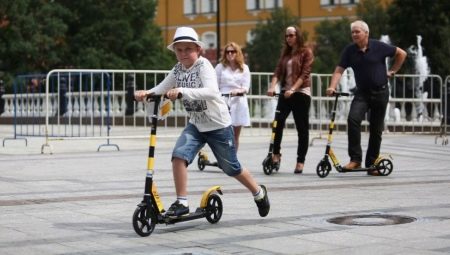
A two-wheeled scooter is one of the most recognizable and widespread types of light transport, widely used in the vastness of our country. 10-20 years ago, he stepped into the shadows for a while in the face of a crushing onslaught from fellow bicycles, but recently there has been a clear trend towards the return of scooters to widespread use. At the same time, such transport is still much inferior to bicycles, and for some categories of citizens it may even turn out to be a kind of exotic, therefore it is worthwhile to figure out what it is and why it is needed.



What age are they suitable for?
Being very popular in Soviet times, the two-wheeled scooter was considered a purely child transport - you had to push off with your foot, and in this way you won't go very far. With the mass distribution of light electric vehicles on batteries, one of the designers came up with the idea of releasing scooter with a motorand it was a real breakthrough. Against the background of the fact that more and more people in the world are abandoning private cars, and public transport at rush hour is another challenge, it is not surprising that the 2-wheel scooter, already significantly modernized, has become of interest not only to children, but also to respectable adults.
Today it is even difficult to say for what age scooters on two wheels are sold more, but we can confidently say that they are produced for almost all categories of the population - from kindergarten children to adults. The load capacity of adult models, reaching 120 kg or more, speaks for itself - if you know how to keep your balance and for some reason do not want a bicycle, this option may be optimal for you.
Modern models are sometimes designed to overcome serious distances - according to the passport, some are able to overcome a good hundred kilometers without recharging. Such scooters are even equipped with a comfortable bicycle seat, so one cannot even dare to call them frivolous or children's transport.



Species overview
Modern manufacturers offer such a wide variety of models that scooters can be classified according to a large number of criteria, even if we are talking only about two-wheeled models. We will consider the most common types of classification in order to make it clear to the reader what to focus on.
Today the norm is both children's and adult scooters, differing in carrying capacity, dimensions, weight, speed (faster in adults) and engine power... Such a division is very superficial, but there is also a more detailed one, according to which the category of children's scooters includes models for the age of 1-8 years, for children from 8 to 12 years old, transport is called adolescent, from 13 years old - transitional, and adult vehicles are allocated.
Adult models are made solid, with a wide iron footboard and the ability to withstand up to 150 kg, so that an adult of average build can take both a child and a heavy backpack with him.


The scooters are divided by the type of ride for urban, stunt and universal... The names of the categories, in principle, speak for themselves - for example, urban in a large city replaces personal transport. Usually it has large wheels for faster driving, a hand brake, headlight illumination (sometimes - glowing wheels), often it is also a foldable model that fits into any elevator or trunk of a car.
The stunt's task is fundamentally different - they do not ride it, but rather ride, practicing spectacular tricks of extreme content, therefore, the most important thing for him is such a design detail as good shock absorbers.
Universal models are designed to provide a solution to both problems - to be a transport, and an acrobatic-gymnastic apparatus.
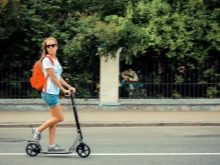


Besides, modern scooters are also divided according to the type of how they are propelled. The classic type is a model familiar to everyone from childhood, in which only one foot is placed on the deck, while the second plays the role of an engine, pushing the driver along with the vehicle away from the starting point. Two-wheeled scooters inertial type sometimes they call what has become widespread in the past few years under the name "segway" - there is a motor, but the vehicle is controlled not by buttons, but by tilting the body in the right direction, and the wheels are located not in front and behind the deck, but on the sides ...
The electric scooter has actually caused a new wave of popularity for this vehicle, it works roughly on the principle of a very simple scooter, only from a battery capable of repeated recharging. There are also very rare gasoline and even kerosene scooters, which differ from the same scooter only in an extremely lightweight frame.



Manufacturers
For many consumers, the best way to choose a scooter is not to go into technical details, but simply to opt for a well-known brand that has been tried and tested by millions of consumers around the world. Sometimes it works, because we, remembering that everyone has their own understanding of the best scooter, let's briefly consider a few top manufacturers - again, without insisting that they are the best.
- Navigator. One of the most popular manufacturers of children's scooters, which will fall in love with a child in its products in bright colors from pink to blue and with beautiful illuminated wheels.A good assortment of models for all ages and heights.
- Next... Another recognizable company that focuses specifically on children's transport. It is distinguished by a combination of attractive appearance, convenience for the baby, even if he does not know how to ride yet, and good stability.
- Tech Team. The brand offers scooters of different types and age groups, but is not least famous for its stunt models. These are suitable both for simple riding in the yard and for improving the skills of avid scooter lovers.
- Razor. Quite expensive transport from among high-quality, many people like it because of silicon brakes with real sparks.




Criterias of choice
Despite the fact that some manufacturers write about "scooters for children from 1 year old" in their specifications, it is worth buying such transport for a child from 4 years old and older. If it is a scooter for children, pay close attention to the model's ability to adapt to the height of the young passenger. It is advisable to choose models height-adjustable steering wheel (and sitting, if any), because at 7-8 and 9-10 years old, the same child is very different in height. When choosing a child model, it is also important to follow design - a scooter for a girl is unlikely to please a boy and vice versa.
If the passenger is an adult, start from his height, which is unlikely to change, and pay attention to the deck's carrying capacity - it is advisable that it be more than the weight of the owner with a margin.
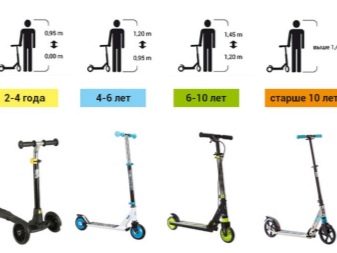

An important criterion is also wheel material... If preference was given to inflatable rubber wheels, the ride comfort on uneven roads will increase significantly - the cameras will perform a shock-absorbing function.
The alternative in the form of polyurethane wheels is more suitable for smooth road surfaces, but at the same time they are completely impervious to driving on sharp objects, practically do not wipe off and do not need regular pumping up.
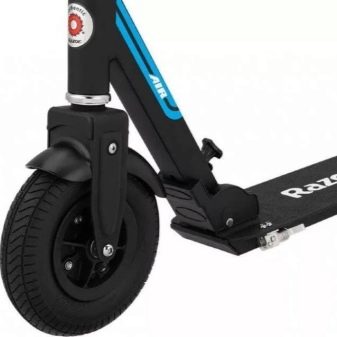

Wheel diameter also matters... Small wheels are suitable only for smooth roads, so they would lose the competition crushingly, if not for one "but": a folding model with small wheels when folded becomes extremely compact, and it always weighs less. In all other respects, large wheels look more priority - they effectively smooth out any irregularities in the road, and help to move faster due to the fact that the wheel diameter is larger.
Steel or aluminum is used as the main material for the manufacture of scooters. In terms of strength, they are about the same in the sense that both can support human weight normally. If we talk about the mass of transport, then it is more logical, of course, to take the aluminum model.


Handlebar adjustment is important in the situation described above with a growing child or when several people of different heights are using the same scooter at the same time. Moreover, trick models are usually fundamentally deprived of such a function - in a situation with serious loads, it is highly desirable that the scooter is guaranteed not to work out, and the "tricksters" themselves are usually already adults.
A scooter brake is required, it can be foot (in the form of an overlay on the rear wheel, which is stepped on) or manual - like a bicycle... The first option is preferable for beginners, since it is believed that it is easier not to fall this way, but it is the hand brake that will be more effective when the owner masters the driving technique.


User manual
Even if you bought a disassembled scooter, it is usually easy to assemble it - instructions are always included in the delivery kit, and the unit itself does not consist of so many parts and everything is intuitively clear in it.
The child is theoretically ready to learn how to ride at the age of 1.5 years, but there is no need to force him if he does not show any interest in this. Please note that such young children are usually taught on three-wheeled models, but two-wheeled ones are relevant from 4-5 years old.
For training a child, they usually choose models with small wheels of medium weight, which are not able to accelerate too much.
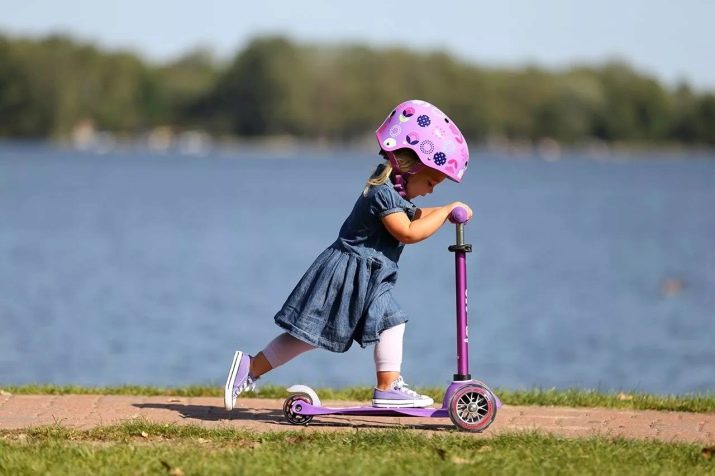
Steering wheel must be adjusted before driving - the child's arms, bent at the elbows, should be located no higher than chest level. It is also important to choose a place with smooth asphalt - any unevenness will complicate the task. Ask the kid to stand on the scooter and in this position state the basic rules: you must hold the steering wheel with both hands and push off the ground with your foot, placing the other on the deck.
During the instructions and the first tests, hold the child with your hand so that he does not fall and quickly finds the balance point - for this, it is advisable to lean forward a little. It is unacceptable to arch your back back.
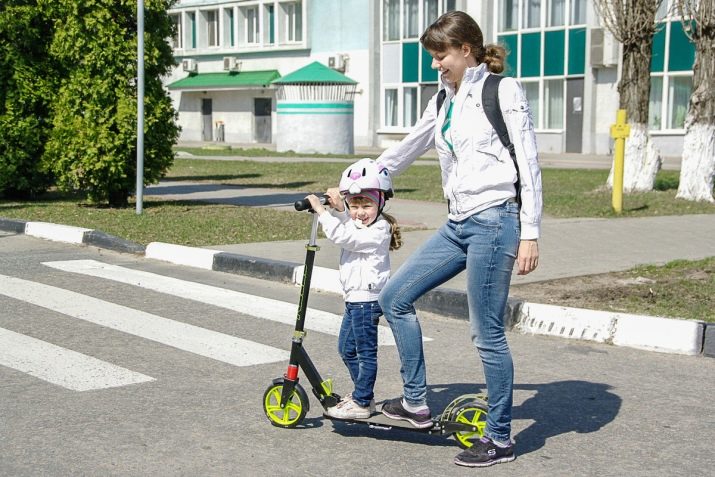
Gradually decrease the value of control - have the child who gets used to try to ride a little without support.... Do not try to master turns until the rider has learned to ride confidently in a straight line - only then explain that the steering movement should be smooth. Tell the young driver how the brake works, and be sure to emphasize that hard braking is undesirable - it should be done gradually.
In teaching an adult, in general, the same rules are relevant, with the only difference that, perhaps, no one will hold him, therefore he will have to remember the skills of maintaining balance on a bicycle.
An overview of the two-wheeled scooter Razor A6 awaits you further.








